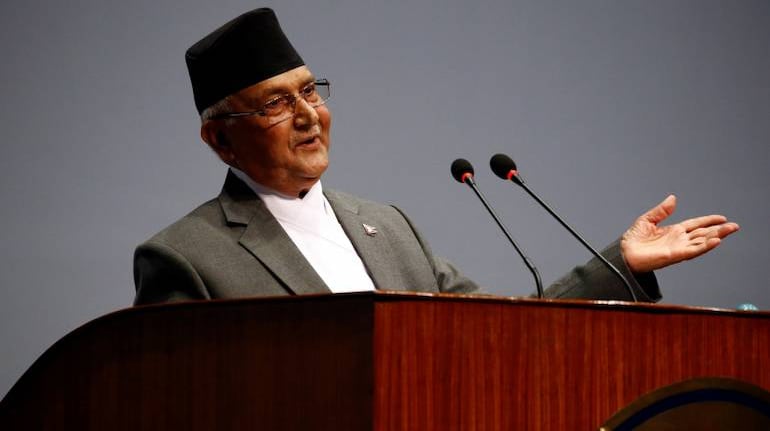
In what raised eyebrows in the subcontinent, Nepal’s Prime Minister Khadga Prasad Sharma Oli, on June 28, claimed that meetings were being organised in India to unseat him and to topple his government.
“Plots are being hatched to topple me for releasing the country’s new map and getting it adopted through Parliament,” Oli said while addressing a gathering at his official residence, to mark the 69th birth anniversary of the late communist leader Madan Bhandari.
“Given the ongoing intellectual discussions, media reports from New Delhi, [Indian] embassy’s activities, and meetings at different hotels in Kathmandu, it is not very difficult to understand how people are actively trying to unseat me. But they won’t succeed,” Oli added.
He added that India was upset over Nepal’s territorial assertion.
The recent strain in relations between New Delhi and Kathmandu is being attributed to Nepal giving constitutional status to a new map of the country which includes the Limpiadora-Kalapani-Lipulekh region that is in India’s state of Uttarakhand.
Why now?
The 68-year-old’s comments come at a time when he is being widely criticised in Nepal for failures on multiple fronts, especially his handling of the novel coronavirus pandemic.
Political observers suggest that Oli resorted to altering the country’s map, to invoke a sense of nationalism among people and deflect criticism away from his government.
But, Oli’s comments were not just aimed at the Indian government, but also at his political rivals at home.
Oli was also criticised by colleagues from the ruling Nepal Communist Party’s faction led by former prime minister Pushpa Kamal Dahal ‘Prachanda’ in the ongoing Standing Committee meeting.
Even though Dahal supported the new map saying that the land “lost during the period of monarchy is being returned under the republican system”, his supporters have been protesting what they call Oli’s unilateral manner of decision-making in the party and in the government.
Under pressure
At the Standing Committee meeting on June 25, Dahal had reportedly charged Oli with continuing to run the party unilaterally, despite having agreed to give him more room within the party as the executive chair.
“Either we have to part ways or we need to mend ways,” a party leader quoted Dahal as saying, according to The Kathmandu Post. “Since parting is not possible, we need to mend our ways, for which we must be ready to sacrifice.”
Political observers suggest that by “sacrifice”, Dahal would ask Oli to step down as either the prime minister or the party chief.
Dahal also openly expressed regret at having “allowed” Oli to run the government for full five years by accepting the executive chair’s post, reports suggest.
The country is no stranger to political instability. Since 2008, when Nepal became a Federal Democratic Republic, it has seen 11 different Cabinets led by nine prime ministers.
Those close to Oli maintain that some “greedy” leaders in Nepal are “trying to cash in” on any attempts at toppling the Nepali government.
Satya Narayan Mandal, a Standing Committee member who is close to Oli, told The Kathmandu Post: “Everyone knows that India wants to oust Oli, not within a minute but in seconds. And some of our greedy leaders are trying to cash in on this and are opposing the government’s activities.”
Yet, the move to introduce the new map did help Oli briefly secure support within his party and among the masses as it was seen as a matter national security and territorial integrity.
“Stung by his own party's opponents, PM Oli has started pointing fingers at foreign elements for making bid to topple his government. It is the strategy of a bewildered ruler,” Lok Raj Baral, a professor of political science wrote on Twitter.
Not the first time
Invoking nationalism in times of political crisis is Oli’s tried and tested tactic.
In 2015, Oli became the prime minister of Nepal for this first time largely riding on the wave of nationalism he created by opposing the border blockade that year and signing a trade and transit treaty with China. The treaty was seen as reducing landlocked Nepal’s dependency on India for connectivity.
On June 28, Oli did bring up the agreement with China and highlighted how his then government had been toppled. He was referring to Dahal’s then Communist Party of Nepal (Maoist Centre) allying with rival Nepali Congress to topple Oli’s government in August 2016.
It was only in late 2017 that Oli and Dahal forged an electoral alliance in the lead-up to the election. They secured a majority and formed the government headed by Oli in February 2018. Months later, Dahal’s CPN (Maoist Centre) and Oli’s Communist Party of Nepal (Unified Marxist–Leninist) announced a formal merger to form the Nepal Communist Party (NCP). With the unification process still incomplete, the two factions remain at odd.
Discover the latest business news, Sensex, and Nifty updates. Obtain Personal Finance insights, tax queries, and expert opinions on Moneycontrol or download the Moneycontrol App to stay updated!